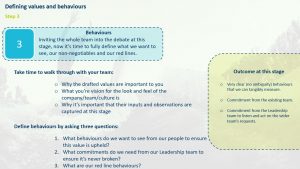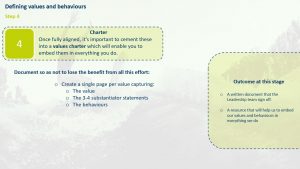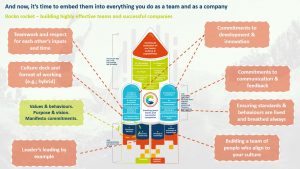At the last Smart Cookies Breakfast Club, Sarah Williams (Founder of Rocko) shared her top tips on developing and embedding your company culture and values.
Everyone wants to build a strong, resilient and productive company.
In doing that, it’s essential that leaders actively plan, grow and protect a culture that attracts and motivates people to be their best selves. And that those people will work together as a highly effective team in the pursuit of your goals. A culture that truly embodies the vision and principles of the founders.
In this session, Sarah took us through the first few stages of their ‘Rocko Rocket’ – a framework for building great companies, teams and cultures.
She guided us through the steps required to devise company values and behaviours that truly capture what it means to be part of your company and journey. Ensuring these are embedded in everything you and your team do at all stages of growth.
You can watch the replay below or read on for a write-up…

Why are values and culture so vital for companies?
To explore this it’s essential that we delve deeper into the definitions of culture and values. We started by taking a look at the values of some big brands.
Written values don’t always result in consistent commitment to them. When left to be subjective, values can be open to misinterpretation.
First, we took a look at Uber’s: “We do the right thing. Period.”
It’s a nice statement, but what does it actually mean? If we were to write out what it means to us, we’d all have different things to say. Is it to do the right thing from a business perspective? A customer perspective? A team perspective?
This demonstrates why you should actually articulate what your values mean, not just state them.
Then, we moved on to BrewDog who have had some negative press recently.
In light of the recent open letter written by employees of BrewDog, their values make for an interesting read. Their first value is "ruthless". One has to wonder if some of the management team has taken the ruthless value too far. BrewDog most certainly didn’t set out to condone bullying, which is why, again, it’s so important to articulate what you mean.
Another thing to point out is that BrewDog has contradictory values. There’s "togetherness", and there’s "ruthless". They also list "honesty" as a value, but the gold can competition controversy would suggest that this value is not being lived.
This highlights why it’s important that you actually define your values because a statement can be subjective and mean different things to different people. It’s worth pointing out that there isn’t really a bad culture. Being ruthless is not necessarily a bad thing (if people are bullying, then that’s a different story), but explain what you mean by it, and then people can decide if they want to join you or buy from you for themselves.
Building your values and behaviours.

Next, Sarah walked us through the 4-step process Rocko use to help leaders build their values and behaviours.
Step 1: Bring the founding team together.
The first step is bringing together the founding/leadership team because they have to be totally aligned. It’s really important that you agree together where your red lines are, what’s important to you and what you’ll accept and what you won’t accept.
If you’re not aligned in front of your team, they are going to get concerned or feel that the values lack cementation.
Step 2: Decisions & definitions
The second step is to actually decide what those words or statements are going to be and what they mean. Your top-level values and the substantiators.
Step 3: Behaviours
Then you need to apply behaviours to those statements. Define what is right and what is wrong and right, so that people are really clear about what they should be doing at work.
Step 4: A charter
Lastly, Rocko recommends developing a charter. A written document where individuals actually sign up and agree that this is how to behave moving forward.
Let’s look at these steps in a bit more detail…
Step 1: Leadership team

The leadership team need to decide on values themes. Pull everyone together, have some debates and start thinking about what’s important to you personally and professionally. This should throw up some values themes.
Then you need to start thinking about how you actually go about living these values. Some key questions to ask yourself here are:
- What do I like/love to see in teams/companies?
- What is an absolute non-negotiable for me?
- What are my red lines (i.e. what I won’t accept)?
Step 2: Bring themes together and define

You’ll likely have used up a lot of Post-it notes brainstorming values themes in step 1. Now it’s time to group them together and define the values categories.
Then it’s time to come up with those headline substantiators – the definitions that tell you what the themes really mean. These should come together to form your values statement. The outcome here is a list of defined values that the leadership team is fully aligned on.
Alignment of the leadership team really is key here. If you’re not aligned, you’re not going to live them!
But how does defining values and behaviours work in practice?
Example: Buffer

This grid demonstrates how Buffer have developed their value statements (headings) and the substantiatiors (bullet points underneath). This removes subjectivity and brings those statements to life.
Step 3: Behaviours

So now you have your value statements and you’ve got your substantiators, it’s time to go into behaviours. What’s acceptable and what isn’t.
At this stage, Sarah recommends bringing the term on board – they will help you, and the exercise will help them be part of the journey and formulate what those behaviours are.
The team can also share what they’d like to see in terms of leadership too. The outcome of this step is that you’ll have really clear behaviours defined and commitment from leadership and the wider team.
So, how do you actually do this?
The first step is to explain why you’ve come up with your values in the first place. Take the team on the journey you went through so that they understand it.
Then, ask the team to get involved. Say, "Look, now we need your help to make sure we articulate what that looks like in everyday behaviours." Three key questions to help you here are:
- What behaviours do we want to see from our people to ensure this value is upheld?
- What commitments do we need from our Leadership team to ensure it’s never broken?
- What are our red line behaviours?
Sarah recommends making this an interactive workshop – get those Post-its out if you’re able to meet in person! Tools like Miro work well for this in a remote setting if you aren’t.
Step 4: The charter

The final step, pulling together your charter, is really important to start to cement and embed those agreed values, substantiators and behaviours. The idea is that every individual in the organisation signs up to this.
Your charter will ideally be a written document, compiling all of the information you’ve pulled together as a team.
Example: Infrastar

Infrastar are based in Cheltenham. They have unbreakable partnerships as their value, and then they’ve got three substantiators underneath.
Then they’ve got what they love to see in their people, the behaviours, what they need to see from their leaders, the behaviours.
Their red lines are underneath what they won’t accept as a team. They’re not going to accept people ignoring each other, failing to listen, working in isolation. So very clearly, when you read that, you can kind of get a feel for what it’s going to be like working for that company. It’s really articulated. Whereas if you just saw unbreakable partnerships, that would mean different things to different people.
Embedding your values
Finally, you need to work on properly embedding those values and behaviours. You’ve done lots of hard work coming up with them; now you want to make sure it’s not just a tick box exercise. In comes the Rocko Rocket.

This is Rocko’s tool for demonstrating the steps you need to take to build a successful, sustainable company. The rocket is something taken from some really famous, well-known business people, like Jim Collins and Verne Harnish. It’s something that fundamentally works for companies.
Sarah took us through the first part of the rocket – defining values and behaviours – but there are a few more elements to pay attention to if you want to truly embed them.
- The most important thing before anything else is to ensure your leaders are living your values. If you put out a value of trust, then run a competition for a gold can that isn’t gold, you’re obviously not living that value.
- Build a team that aligns with your values. Incorporate something into your recruitment process that helps you identify who’s going to be most aligned to your values.
- Create a culture deck – this takes the statements in the charter and elaborates as well as some more information about your general work culture. Ways of working, working hours etc. can all be included in here, helping to cement the culture.
- Look at standards and behaviours – ensure the team are actually living it and pulling each other upon it. Ask them to identify real-life examples of where someone (outside your organisation even) is not living by your values.
- Communication and feedback – commit to communicating and feeding back to people if they’re not quite living the values, or celebrating when they are!
- Commit to development and innovation – if one of your values is around innovation and development, are you actually giving people time to do that? If you’re all working nonstop, 60 hours a week, how are you actually getting time to develop or innovate? Really think about the practicalities of your values.
- Consider your rewards process – say, for example, you had a teamwork value. If you decide that you’re going to reward people by giving them individual performance pay, then that’s not going to be conducive to the value of teamwork. Teamwork would be more about a bonus that was split across the whole team, because that’s going to be encouraging teamwork rather than silo working. So this is why it’s really important that the values are always nailed first, before you go into things like performance management. How are you going to reward people? How are you going to feedback to people? Those values go through everything you do.
The Rocko Club and Leader’s Checklist
That should all get you well on your way to developing and embedding your company culture and values! Some further useful resources to help you:
- Download The Rocko Rocket Leader’s Checklist – designed by Rocko to show you where your HR gaps are.
- Check out the Rocko Club – a free club for anyone working in people or operations. There are a bunch of resources available, as well as a community to reach out to for input.
- You can download Sarah’s slides here →
A big thank you to Sarah for such a great session – you can find out more about what she’s up to by following her on Twitter or connecting with her on LinkedIn.
Why not join us at our next Smart Cookies Breakfast Club session? Bitesize chunks of top quality content to help you take your business to the next level, all before 9 am!